
Wearable technology is all over the news these days, but we have been dreaming of it for a long time (remember Dick Tracy, Inspector Gadget, and Maxwell Smart?)
Wearable technology spans a multitude of different forms and uses – from frivolous and fun to life-enhancement and survival. From prosthetic limbs, expensive smart watches, fitness bands, to clothing you can make yourself, wearable technology is all around us.
The new Apple Watch© will be in stores tomorrow (April 24, 2015). It is the first of the major smart watches to support mobile payments and with Digital Touch you can scribble emoji or send audio messages like a walkie-talkie (remember Dick Tracy?). It also can replace the fitness band, tracking calories, exercise and even time spent standing.1
To go with that new Apple watch, Fitbit, or Jawbone fitness band, why not try having your music play faster with “Perform-o-shoes.” Developed by Andrew Schneider, Perform-o-Shoes have a photocell embedded in the heel of the shoe. The higher the heal is lifted off the ground, the faster the music track plays.2 This might help you reach those fitness goals more quickly!
Prosthetic body parts have been around a very, very long time. A 3,000 year old Egyptian mummy was found to have a wooden big toe grafted to her right foot. It was expertly carved and painted to match her skin tone.3 Over the years, artificial limbs have become more and more sophisticated. Prosthetic limbs that can feel are now being developed. Sensors were wired into the fingers of an artificial hand to sensory nerves in Dennis Aabo Sorensen’s upper arm. He is now able to feel “…round things and soft things and hard things….” That sensory feedback also improves a patient’s ability to control the prosthetic.4
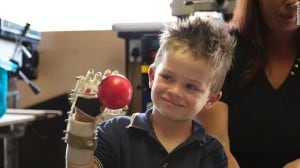
Richard van As and Ivan Owen launched the company “Robohand” in 2012. Robohands are affordable mechanical prosthetics made with 3-D printers. The first one was created for five-year-old Liam, who was born with no fingers on his right hand. “Within minutes of being fitted with his newly printed mechanical hand, Liam beamed excitedly and expressed how he could now ‘pick up stuff,’ describing its movement by saying: “it copies me.”5
Google has just filed a patent for “Nanoparticle Phoresis.” It proposes tiny magnetic particles in the patient’s bloodstream, which, when activated by a smart wristband, would attack cancer cells.6
High-tech clothing is being developed with an eye for various uses. Some of this high-tech clothing is being used with autistic children. The clothing has a GPS tracker slipped inside a soft pocket on each garment. The child doesn’t see or feel it, and parents have the peace of mind that comes with knowing their wandering child can be safely tracked.7 There is another innovation in wearable tech can also put a parent’s mind at ease. A smart shirt may be able to be used with infants to help eliminate Sudden Infant Death Syndrome (SIDS). The smart shirt is customized to monitor vital signs and other data from sensors that are woven into the fabric.8
Are you often cold? Smart shirts and jackets can now measure skin temperature and then heat the clothing to a comfortable range. In Wearable Electronics and Photonics we learn about Reima, a survival suit. It is designed to help prevent accidents and assist in survival in harsh winter environments. With its integrated sensors it monitors the wearer’s location, movement and health. The suit will also contact an emergency office when the user has an accident or an abnormal situation is detected.9
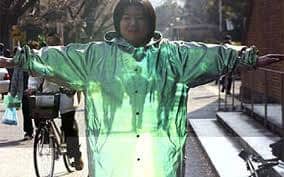
Want an invisibility cloak? Susumu Tachi developed the “Optical Camouflage,” or “Retro-reflective Projection Technology.” It uses a projector, camera, reflector and head-mounted display. A little unwieldy for sneaking out of lectures, however!10 Interested in seismology? The “Earthquake Skirt,” designed by Erin Lewis, shakes or shimmies whenever there is an earthquake in the world. It picks up the seismologic data from the internet.11
Do you have an innovative idea for wearable technology? Make: Wearable Electronics can walk you through the design process and creating a prototype. What materials, sensors, power sources, tools – everything you need – is covered. Want to try your hand at creating wearable tech, but don’t have “the” idea? Page through and find your inspiration – from safety shirts that light up to Super Hero Communicator Cuffs – your creation is just an inspiration away!
Jaymes Dec developed “Glowbowz” to help get 4th and 5th grade girls interested in wearable technology.12 If Glowbowz inspires you to want more glow in your life, LED neckties, jewelry, handbags and LED eyelashes are available.13 The eyelashes might pair nicely with the “Galaxy Dress,” designed by CuteCircuit.14

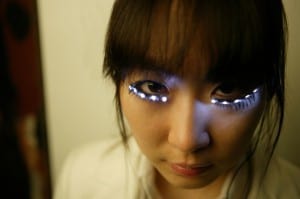
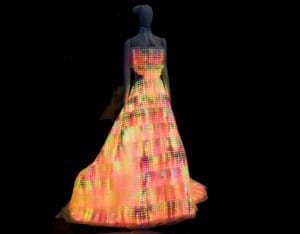
- Wearable tech is all round – are you ready to try your hand at creating your own?
REFERENCES:
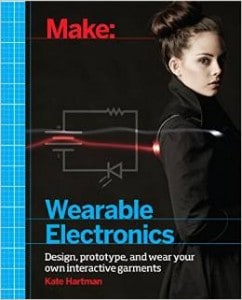
- Apple watch: everything you need to know, so far and hands on impressions. March 9, 2015. c|net, CBS Interactive Inc.
- Hartman, Kate. Make: wearable electronics. 2014. Sebastopol, CA : Maker Media. pg. 136.
- Once more with feeling. Oct. 11, 2014. The Economist. The Economist newspaper Limited, 2015.
- Revolution in artificial limbs brings feeling back to amputees. Feb. 22, 2014. National Geographic.
- Carpenter who cut off his fingers makes “Robohand” with 3-D printer. Jan. 15, 2015. CNN.
- Conrad, Andrew Jason.Google, Inc. “Nanoparticle Phoresis.” Patent Application No. PCT/US2014054321
- These high-tech shirts and pants can help protect kids with Autism. Feb. 18, 2015. Huff Post The Third Metric. Huffington Post.
- Cho, Gilsoo, editor. 2010. Smart clothing: technology and applications. pg. 130. Boca Raon, Fla. : CRC ; London : Taylor & Francis.
- Tao, Xioming, editor. 2005. Wearable electronics and photonics. pg 216-219, Cambridge : Woodhead, Boca Raton, FL : CRC Press.
- Pederson, Isabel. 2013. Ready to wear: a rhetoric of wearable computer and reality-shifting media. pg. 52, Anderson, SC : Parlor Press.
- Hartman, Kate. Make: wearable electronics. 2014. pg. 209. Sebastopol, CA : Maker Media.
- Hartman, Kate. Make: wearable electronics. 2014 pg. 137. Sebastopol, CA ; Maker Media.
- Hartman, Kate. Make: wearable electronics. 2014 pg. 149. Sebastopol, CA : Maker Media.
- Hartman, Kate. Make: wearable electronics. 2014. pg 145 Sebastopol, CA : Maker Media.
MORE RESOURCES:
- King, Paul H. Design of biomedical devices and systems. 2015. Boca Raton, Fl : CRC Press, Taylor & Francis Group. Engn R856 .K53
- Cranny-Francis, Anne. Technology and touch: the biopolitics of emerging technologies. 2013. Houndsmill, Basingstoke, Hampshire ; New York, NY : Palgrave macmillan. Engn T173.8 .C736 2013
- How it’s made. Seasons 1 and 2 (DVD). 2010. [Silver Springs, MD] : Discovery Communications. Engn Circ Desk 37144 DVD
- Perkowitz, Sidney. 2004. Digital people: from bionic humans to androids. Washington, D.C. : Joseph Henry Press. Engn TJ211.15 .P4768 2004
- Smart artificial skin could give prosthetic limbs feeling. Dec. 10, 2014. IFL Science.
- The best fitness trackers you can buy right now. Feb. 6, 2015. c|net. CBS Interactive Inc
- Fab Lab Maker Space. Posted Dec. 4, 2013. youtube.